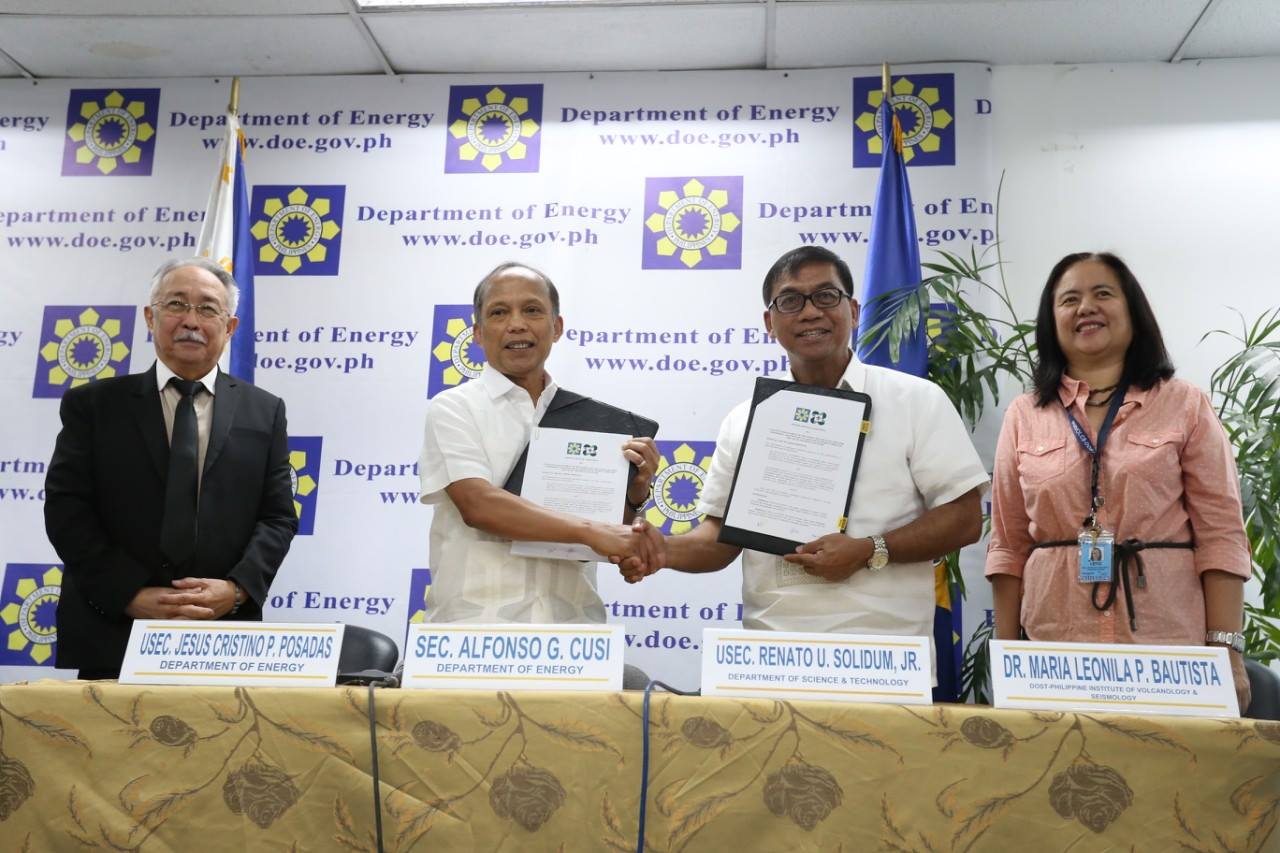Alice Sicat

DOE AND DOST MOVE TO SECURE THE ENERGY FACILITIES. The DOE and DOST signed on 16 March 2018 a Memorandum of Agreement (MOA) to enhance the capacity of the energy sector in assessing the risk hazards of an impending earthquake that may have adverse impacts on energy facilities and services as well as people. The MOA entails training on the use of the Filipino-made Rapid Earthquake Damage Assessment System (REDAS) software, which is a tool for preparing and responding to calamities and disasters. Sealing the deal with Energy Secretary Alfonso G. Cusi is DOST Undersecretary Renato U. Solidum Jr. with DOE Senior Undersecretary Jesus Cristino P. Posadas and PHIVOLCS Associate Scientist Dr. Maria Leonila P. Bautista as witnesses. (DOE)
TAGUIG CITY, Mar. 17 -- “Wag na tayong magpatumpik-tumpik pa,” Department of Energy (DOE) Secretary Alfonso Cusi said during the signing of an agreement with the Department of Science and Technology (DOST) on Friday (16 March 2018) to use a Filipino-made software to enhance the capacity of all stakeholders in earthquake readiness.
This is a timely response to the magnitude 6.5-earthquake that hit Visayas last year, affecting electricity supply delivery in Leyte, Samar and Bohol. This incident revealed the vulnerability of the country’s energy systems to earthquakes.
Cusi pointed out, “It is the mandate of the DOE to ensure that energy services will be available to everyone immediately after an emergency situation.” This pronouncement supports President Rodrigo Duterte’s directive to ensure disaster resilience.
“We need all available tools and technologies to enhance our resiliency planning and implementation,” Cusi emphasized, citing the threat of a magnitude 7.2-earthquake and other calamities, which pose risks to operations in the energy sector.
The Memorandum of Agreement (MOA) entitled “Capacity Enhancement of the Energy Sector on Hazard, Risk Assessment and Exposure Database Development Through the Use of the Rapid Earthquake Damage Assessment System (REDAS) Software” was inked on Friday (16 March 2018) at the DOE-Media Center in Taguig City by DOE Sec. Cusi and DOST Undersecretary Renato Solidum Jr., and witnessed by DOE Undersecretary Jesus Cristino Posadas and DOST- Philippine Institute of Volcanology and Seismology (PHIVOLCS) Associate Scientist Dr. Maria Leonila Bautista.
For the energy sector’s capacity enhancement, the MOA outlines the development of database on hazard, risk assessment and exposure to earthquake through the use of the DOST-PHIVOLCS’ REDAS software. It can be used as a tool for emergency preparedness, contingency planning and mainstreaming disaster risk reduction.
Under the MOA, the DOE and PHIVOLCS would undertake and pursue intensive REDAS training, endeavor knowledge and resources sharing to complement each other on the implementation of the program, among other assistance and cooperation needed for the attainment of the goals and objectives to prepare the energy sector on possible earthquake hazards.
REDAS will be helpful in providing quick and near-real-time simulated earthquake hazard information to disaster managers which will help them in assessing the distribution and extent of the impacts of a strong earthquake to their people and assets. The data generated could also provide information and insights for better resource management and asset resiliency.
REDAS can be used to compute ground-shaking, earthquake-induced landslides, liquefaction and even tsunamis. Other capabilities of the tool include earthquake sorting capability, generating seismicity maps, onscreen map digitization and building of database on earthquake hazard risks as well as wind hazards.
The partnership of the DOE and DOST-PHIVOLCS is also in line with the recently signed Department Circular No. 2018-01- 0001 or the “Adoption of Energy Resiliency in the Planning and Programming of the Energy Sector to Mitigate Potential Impacts of Disasters”, also known as the Energy Resiliency Policy.
The Energy Resiliency Policy was issued as a foundation to make the Philippines an energy-resilient country. The policy also aims to unify the energy sector in mainstreaming disaster risk reduction in its plans, programs and activities.
The policy likewise seeks to institutionalize the strengthening of energy systems and facilities, and to enable the quick restoration and provision of an alternative power source that will alleviate consumer conditions during emergencies and disasters.
“Because of this partnership with PHIVOLCS, more collaborative efforts within the energy sector will result and in the end, it will make the country more competitive,” Cusi said. (DOE)




